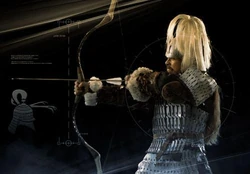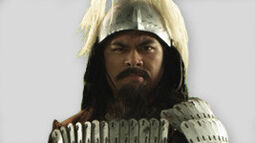| Genghis Khan | |
|---|---|

| |
| Weapons | Turko-Mongol Saber, Jida Lance, Recurve Bow |
| Origin | Asia |
| Activities | leading the Mongol army to conquer other nations
Ruler of the Mongol empire |
| Service | 1206-1227 |
| Battle Status | Won vs. Hannibal Barca |
| Experts | Khosbayar (U.S. Marine & Mongol Weapons Expert)
Timothy May, PhD (Author, "The Mongol Art of War") |
"The greatest joy for a man is to defeat his enemies, to drive them before him, to take all they possess, to see those they love in tears, to ride their horses, and to hold their wives and daughters in his arms."- Genghis Khan
"Genghis never lost a single battle in his life." - Khosbayar, Mongol Weapons Expert
Genghis Khan, the 13th Century Mongolian ruler whose legions built the greatest empire of all time;
Hannibal, the Carthaginian general whose army of elephants terrorized Rome, the greatest empire of its time.
Stats
- Era- 1206-1227 AD
- Age- 39 - 69
- Height- 5' 8" (173 cm)
- Weight- 170 lbs (77 kg)
- Symbol- Steel Helmet
History

Genghis Khan is actually a title meaning "Great Khan" (or Mongol chieftain). Genghis Khan's birth name was Temujin (which when translated to Mongolian means either Smith or Blacksmith). Born about 1162, was raised until he was around the age of 12 in his father Yesugei's tribe (Kiyad-Borjigin). Yesugei was the Khan of the Mongol tribe that Temujin spent most of his childhood in. After the assassination of his father, he and his family (Mother, brothers and newborn sister) were cast out of the tribe by the right hand man of his father, who succeeded him after his death. He then, lived off of wild berries, animal carcasses, and small game. Supporting his family, he killed his elder brother Begter for his selfishness while the family was trying to survive in the wilderness. Begter was killing game and finding food only for himself, Temujin, infuriated realized this and killed his older brother. From his rough childhood, he came to unite the many, hostile Mongol tribes into a military force able to conquer half the known world. Genghis Khan was cruel to his enemies, but kind to his own people. He was also kind to those civilizations who swore allegiance to him, allowing them to continue virtually unhindered. However, if a nation resisted, they were annihilated. The Khan was so successful that it is believed nearly 200,000 present-day Mongolians and .5% of the world population are related by blood to him.
Weapons, Armor and Tactics
| Close-Range | Turko-Mongol Saber |
| Medium Range | Jida Lance |
| Special Weapon | Recurve Bow |
| Armor | Steel Lamellar |
| Tactics | Feigned Retreat |
Deadliest Warrior: Legends weapons
Short Range: Mongol Saber, Mongol Mace
Medium Range: Mongol Spear, Glaive
Long Range: Mongol Bow, Mongol Crossbow
Armor: Light Lamellar Cuirass, Heavy Lamellar Cuirass
Joke Weapon: Koi
Finisher: Genghis Khan knees his opponent twice in the chest and face, then grabs their head and twists, breaking their neck.
Simulated Battle
The battle starts with Genghis Khan, who is mounted on horseback, and 4 of his foot soldiers out walking on a hillside. They soon hear a strange noise and see Hannibal , who is mounted up on a war elephant and being accompanied by 3 foot soldiers and a single horseman. Hannibal soon makes visual contact with Genghis, and Genghis orders his men to load their bow and arrows. They aim upwards and fire, one which comes down in Hannibal's shield, and another which sticks in an unlucky Carthaginian. ![]() In retaliation, Hannibal orders his horseman to ride on and attack with Soliferras. As he charges, one Mongol breaks from the group and charges into battle with his Jida Lance, only to be stuck down by one of the Soliferras.
In retaliation, Hannibal orders his horseman to ride on and attack with Soliferras. As he charges, one Mongol breaks from the group and charges into battle with his Jida Lance, only to be stuck down by one of the Soliferras.![]() A Mongol soldier passes his own Jida Lance to the Khan, and he rides off, besting the Carthaginian in a brief jousting match.
A Mongol soldier passes his own Jida Lance to the Khan, and he rides off, besting the Carthaginian in a brief jousting match.![]()
Back on the other side of the hill, Hannibal dismounts from his elephant and prods him on with a Soliferrum to charge at the Mongolians. The 3 Mongolians kneel down and shoot at the elephant with their recurve bow and arrows, but soon retreat as the elephant charges in, trampling one Mongolian.![]() The Mongolians regroup and continue assaulting the elephant with arrows, firing arrows into its hide and head, and driving it away from the battlefield. Elsewhere, Khan rides in on his war horse and strikes down a Carthaginian soldier with his Turko-Mongol Saber.
The Mongolians regroup and continue assaulting the elephant with arrows, firing arrows into its hide and head, and driving it away from the battlefield. Elsewhere, Khan rides in on his war horse and strikes down a Carthaginian soldier with his Turko-Mongol Saber.![]()
Meanwhile, one of the Carthaginians charges at the two remaining Mongolians, catching one's attention by throwing a Soliferrum at his head. The iron javelin is deflected by the Mongolian's shield and both men turn to face the Carthaginian. One tries to hack at him with a Mongol saber, but he deflects the blow and stabs him through his leather lamellar with his falcata.![]() He then tries to strike at the last Mongol's legs, but the Mongol jumps back and slashes his leg. While he is kneeling, the Mongol quickly follows up with a slash to the face, killing the Carthaginian.
He then tries to strike at the last Mongol's legs, but the Mongol jumps back and slashes his leg. While he is kneeling, the Mongol quickly follows up with a slash to the face, killing the Carthaginian.![]() His victory is short-lived, however, as Hannibal comes up from behind and impales him through the chest with his falcata.
His victory is short-lived, however, as Hannibal comes up from behind and impales him through the chest with his falcata.![]()
Genghis Khan soon spots Hannibal again and rides up toward him, throwing away his Mongol bow and dismounting. He walks up to him as both men measure each other up, and then gives a war cry while drawing his saber. Both men clash swords, which are caught by both shields. Hannibal goes for a vertical head shot with his falcata, but Genghis shakes off the blow and slashes Hannibal across the thigh. Hannibal goes for a horizontal slash, but Genghis ducks under the sword and hits Hannibal's shield out of his hands. Tired and desperate, Hannibal deflects blows from the saber and goes for a thrust strike with the falcata, but it fails to pass through the steel lamellar armor. Enraged, the Khan counters with two consecutive head shots to Hannibal's brass helmet, severely denting it and knocking Hannibal dizzy. Genghis Khan then spins around and delivers the final strike, slashing Hannibal across the neck and cutting neck arteries.![]() Hannibal falls down dead as The Great Khan gives a victorious shout.
Hannibal falls down dead as The Great Khan gives a victorious shout.
Expert's Opinion
The reason why Genghis Khan won was mainly because his steel lamellar armor and helmet were far stronger then Hannibal's brass armor and helmet. Hannibal's helmet was breaking more often than Genghis Khan's helmet, which meant Hannibal died more often than Genghis did.
Trivia
- Genghis Khan was illiterate, never learning to read or write, despite being a great military leader.
- In the Season 3 preview on Deadliest Warrior: The Aftermath, Kieron Elliot accidentally said Genghis Khan had already been featured but was referring to the Mongol, when discussing and opponent for Hannibal.
- Genghis Khan is the only warrior to win after getting the battlefield strategy/tactics edge.
- Many scenes of Genghis Khan's army is from the BBC Genghis Khan Documentary.
- The Battle of Kalka River, the battle used to compare Khan's and Hannibal's tactics and strategy, was a battle that Khan never actually participated at. It was lead by two of his generals; Jebe and Subutai, and Khan was far away in Asia at the time.
- Genghis Khan was portrayed in the simulation by Jason Nguyen, who had already represented the Mongols in the Commanche vs. Mongol episode.
- Genghis, as shown on the show, was left handed.
- Ironically, despite his brutal reputation, Genghis Khan has the only finisher in Deadliest Warrior: Legends that has no blood, since he knees the opponent twice and then snaps their neck. Genghis Khan is also the only warrior whose finisher does not involve any weapons at all.
- Genghis Khan censored all pictures and paintings of himself. Any image of Genghis Khan was done after his death.
- Genghis used prisoners of war as weapons during his sieges. Some of his siege weapons were manned by prisoners. Genghis also catapulted humans, alive and dead, over city walls as psychological warfare.
- Genghis Khan actively searched for the elixir of eternal life and other rumors of similar mythical objects of immortality.
- Like Alexander the Great, Genghis claimed on his deathbed that he was dissatisfied with his conquests: thinking he could have done more within his life.